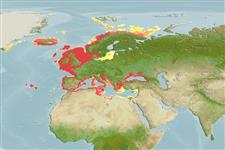Common names from other countries
Environment: milieu / climate zone / depth range / distribution range
Ecologia
; intervalo de profundidade 0 - 250 m (Ref. 78574). Subtropical; 73°N - 21°N, 33°W - 42°E
Northeast Atlantic and the Mediterranean.
Length at first maturity / Tamanho / Peso / Idade
Maturity: Lm ? range ? - ? cm Max length : 1.0 cm TL macho/indeterminado; (Ref. 78574)
Collected from the sublittoral zone, from low tide up to a depth of 200 m (Ref. 2754). A microalgae herbivore (Ref. 96488). This is an epibenthic species found on reefs (Ref. 95730). It is one of the most abundant microgastropods inhabiting the alga Gelidium latifolium and prefers to live at the base of the plant (Ref. 96520).
Life cycle and mating behavior
Maturidade | Reprodução | Desova | Ovos | Fecundidade | Larvas
Members of the order Neotaenioglossa are mostly gonochoric and broadcast spawners. Life cycle: Embryos develop into planktonic trocophore larvae and later into juvenile veligers before becoming fully grown adults.
Demir, M. 2003. (Ref. 2754)
Categoria na Lista Vermelha da IUCN (Ref. 130435)
Categoria CITES (Ref. 108899)
Not Evaluated
Not Evaluated
Utilização humana
| FishSource |
Ferramentas
Mais informação
Idade/Tamanho
Crescimento
Comprimento-peso
Comprimento-comprimento
Morfologia
Larvas
Abundância
Fontes da internet
Estimates based on models
Preferred temperature
(Ref.
115969): 6.7 - 15.7, mean 9.8 (based on 632 cells).
Vulnerabilidade
Low vulnerability (10 of 100).
Categoria de preço
Unknown.
